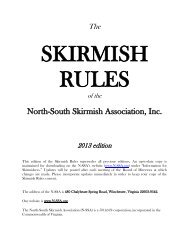Regional Commanders - The North-South Skirmish Association, Inc.
Regional Commanders - The North-South Skirmish Association, Inc.
Regional Commanders - The North-South Skirmish Association, Inc.
Create successful ePaper yourself
Turn your PDF publications into a flip-book with our unique Google optimized e-Paper software.
Returning to First Manassas Fifty Years Later<br />
Many of our most senior skirmishers well recall the July 1961 Civil War Centennial Commemorative Reenactment<br />
of the Battle of First Manassas. <strong>The</strong> Centennial was a very exciting time as the War was getting all manner<br />
of media coverage. <strong>The</strong> last veterans of that war had just passed from the scene in the mid to late 1950s.<br />
My own great grandfathers who served in <strong>North</strong> Carolina units had faded away in middle age during the 1890s<br />
still growing cotton and tobacco just as they had done prior to the conflict. President Dwight Eisenhower had<br />
issued a proclamation in 1957 encouraging the nation to plan appropriate commemorative events to mark the<br />
100 th anniversary of the war. Dwight Eisenhower was a popular President and citizens as well as politicians responded<br />
with genuine enthusiasm in those days before the advent of political correctness. Nowhere was the enthusiasm<br />
greater than amongst the members of the young and growing <strong>North</strong>-<strong>South</strong> <strong>Skirmish</strong> <strong>Association</strong> which<br />
had only come into existence in 1950. Early on, there was a move afoot by public officials to reenact some of<br />
the events, including battles, as a means of educating the public about the War. Reenacting had not yet come<br />
into vogue so the only people with the necessary firearms and equipment were skirmishers and we knew we<br />
would be called upon to give life to these spectacles.<br />
Most of the leaders of the <strong>Association</strong> at that time all are gone. Bill Waters was National Commander, cofounders<br />
Jack Rawls and Ernie Peterkin were in their prime. Bud Purvis, Jim McAleer, Happy Taylor, Joe<br />
Bown, Max Mason, J. M. Walker, Jim Landers, Jack Carroll were local legends known for their shooting prowess,<br />
knowledge of the war, or leadership abilities. Most of us were in our late teens, 20s, or 30s. <strong>The</strong> “old<br />
guys” of the <strong>Association</strong> were men in their 40s.<br />
First Manassas was the first large event to be commemorated during the Centennial. A corporation was set up<br />
to secure funding, the National Park Service was heavily involved since the reenactment was to be held on the<br />
actual battlefield, and a retired Army general by the name of Fry was appointed to be the director of the event.<br />
I’ll always recall him for his horsemanship during the rehearsals which began in the spring of 1961. Army posts<br />
at that time typically had riding stables where officers could keep their mounts. I well remember seeing horsemen<br />
at Ft Meade, MD out riding during skirmishes. It’s hard to imagine the military supporting a skirmish on a<br />
military reservation in this day and time. I can hear the protest against our battle flags now!<br />
<strong>The</strong> reenactment was one of those always-to-be-remembered happenings in skirmishing. Five governors attended<br />
the program. One was the Governor of Maryland who had previously invited all the participating N-SSA<br />
units from Maryland to the State House for a ceremony during which he presented First National Confederate<br />
flags to each unit. <strong>The</strong>se were to be carried at Manassas. As the color bearer for my team, I was present in my<br />
re-worked gray flannel shirt uniform jacket and took the flag from the Governor.<br />
In preparation for the “battle,” all the permanently displayed artillery pieces were removed from the battlefield;<br />
the Visitors Center was camouflaged, as were the monuments. <strong>The</strong> only structure discernable from where the<br />
spectators were was the Henry House on the hill of the same name. Destroyed during the battle by Federal artillery,<br />
the house standing today was constructed in the 1880s. <strong>The</strong> widow Henry was killed during the shelling<br />
and is buried in the family grave yard behind the house.<br />
Held on the stifling weekend of July 22 nd and 23 rd , the reenactment will always be remembered for the 100degree<br />
temperatures. Even during the dress rehearsal on Friday, the 21 st and the date of the actual engagement<br />
100 years previous, it was boiling hot. When Stonewall Jackson appeared on the field in 1861, history records<br />
the temperature was only in the 80s. Nonetheless skirmishers, both <strong>North</strong> and <strong>South</strong>, threw themselves into the<br />
reenactment with a zeal and enthusiasm that would have pleased Cecil B. DeMille. <strong>The</strong> camp site was on Chinn<br />
Ridge, a mile from Henry House Hill and there were no buses. <strong>The</strong> troops walked in the heat of the day for the<br />
reenactment which covered the last phase of the battle beginning at 2:00 p.m. None of this dissuaded the skirmishes<br />
who marched and charged back and forth on the battlefield like school boys, volleying with their original<br />
muskets. Some even brought side-by-side shotguns…and they used their own DuPont powder which at that<br />
time ran $18.75 per 25-lb keg. (Somebody remind Jackie.)<br />
<strong>Skirmish</strong> Line November / December 2011 124



